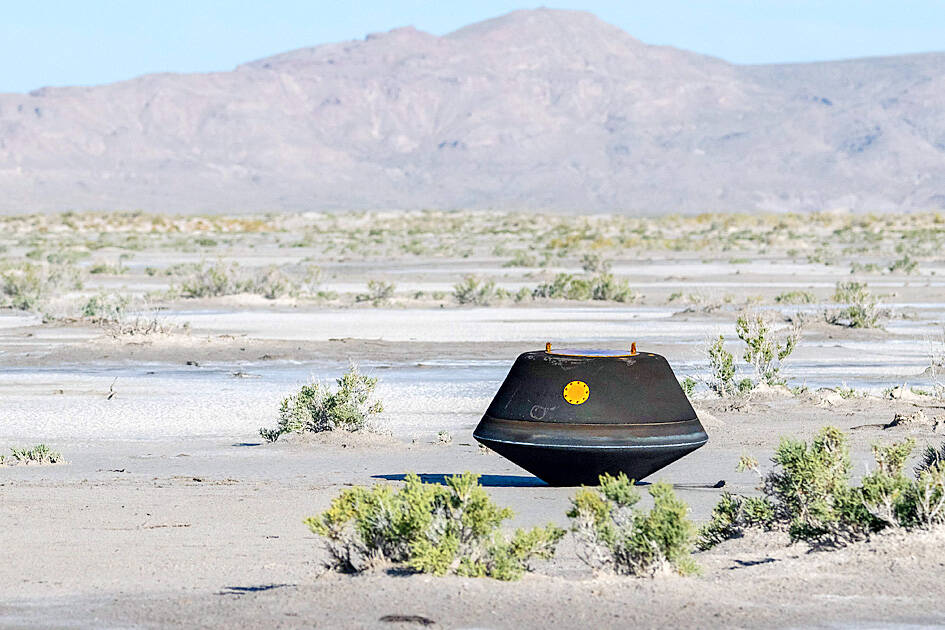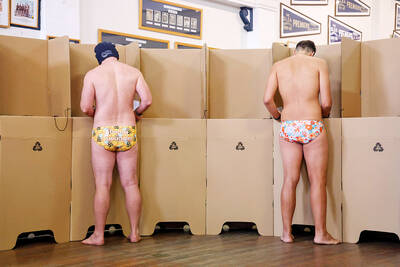NASA’s first asteroid samples fetched from deep space on Sunday parachuted into the Utah desert to cap a seven-year journey.
In a flyby of Earth, the Osiris-Rex spacecraft released the sample capsule from 100,000km out. The small capsule landed four hours later on a remote expanse of military land, as the ship set off after another asteroid.
“We have touchdown,” mission recovery operations announced, immediately repeating the news since the landing occurred three minutes early. Officials later said the orange striped parachute opened four times higher than anticipated — at about 6,100m — basing it on the deceleration rate.

Photo: AFP / NASA / Keegan Barber
To everyone’s relief, the capsule was intact and not breached, keeping its 4.5 billion-year-old samples free of contamination. Within two hours of touchdown, the capsule was inside a temporary clean room at the US Department of Defense’s Utah Test and Training Range, hoisted there by helicopter.
The sealed sample canister was yesterday flown to NASA’s Johnson Space Center in Houston, Texas, where it was to be opened in a new, specially designed laboratory. The building already houses the hundreds of kilograms of moon rocks gathered by the Apollo astronauts.
“We can’t wait to crack into it. For me, the real science is just beginning,” mission lead scientist Dante Lauretta of the University of Arizona said. He was to accompany the samples all the way to Texas.
“Those are going to be a treasure for scientific analysis for years and years and years to come,” said Lori Glaze, NASA’s planetary science division director.
Scientists estimate the capsule holds at least a cup of rubble from the carbon-rich asteroid known as Bennu, but would not know for sure until the container is opened. Some spilled and floated away when the spacecraft scooped up too much material, which jammed the container’s lid during the collection three years ago.
Japan, the only other nation to bring back samples, gathered about a teaspoon during a pair of asteroid missions.
The pebbles and dust delivered on Sunday represent the biggest haul from beyond the moon. Preserved building blocks from the dawn of our solar system, the samples would help scientists better understand how Earth and life formed, providing “an extraordinary glimpse” of 4.5 billion years ago, NASA Administrator Bill Nelson said.
Osiris-Rex, the ship, rocketed away on the US$1 billion mission in 2016. It reached Bennu two years later and, using a long stick vacuum, grabbed rubble from the small roundish space rock in 2020. By the time it returned, the spacecraft had logged 6.2 billion kilometers.
At a news conference, Lauretta said he broke into tears of joy upon hearing that the capsule’s main parachute had opened.
“I knew we had made it home,” he said, so overwhelmed with emotion when he arrived at the scene that he wanted to hug the capsule, sooty, but undamaged, and not even bent.
Flight controllers for spacecraft builder Lockheed Martin stood and applauded the touchdown from their base in Colorado. NASA camera views showed the charred capsule upside down on the sand with its parachute disconnected and strewn nearby, as the recovery team moved in via helicopters.
“Boy, did we stick that landing,” Lauretta said. “It didn’t move, it didn’t roll, it didn’t bounce. It just made a tiny little divot in the Utah soil.”
British astronomer Daniel Brown, who was not involved in the mission, said he expects “great things” from NASA’s largest sample return since the Apollo moon landings more than half a century ago.
With these asteroid samples, “we are edging closer to understanding its early chemical composition, the formation of water and the molecules life is based on,” he said from Nottingham Trent University.

Kehinde Sanni spends his days smoothing out dents and repainting scratched bumpers in a modest autobody shop in Lagos. He has never left Nigeria, yet he speaks glowingly of Burkina Faso military leader Ibrahim Traore. “Nigeria needs someone like Ibrahim Traore of Burkina Faso. He is doing well for his country,” Sanni said. His admiration is shaped by a steady stream of viral videos, memes and social media posts — many misleading or outright false — portraying Traore as a fearless reformer who defied Western powers and reclaimed his country’s dignity. The Burkinabe strongman swept into power following a coup in September 2022

‘FRAGMENTING’: British politics have for a long time been dominated by the Labor Party and the Tories, but polls suggest that Reform now poses a significant challenge Hard-right upstarts Reform UK snatched a parliamentary seat from British Prime Minister Keir Starmer’s Labor Party yesterday in local elections that dealt a blow to the UK’s two establishment parties. Reform, led by anti-immigrant firebrand Nigel Farage, won the by-election in Runcorn and Helsby in northwest England by just six votes, as it picked up gains in other localities, including one mayoralty. The group’s strong showing continues momentum it built up at last year’s general election and appears to confirm a trend that the UK is entering an era of multi-party politics. “For the movement, for the party it’s a very, very big

ENTERTAINMENT: Rio officials have a history of organizing massive concerts on Copacabana Beach, with Madonna’s show drawing about 1.6 million fans last year Lady Gaga on Saturday night gave a free concert in front of 2 million fans who poured onto Copacabana Beach in Rio de Janeiro for the biggest show of her career. “Tonight, we’re making history... Thank you for making history with me,” Lady Gaga told a screaming crowd. The Mother Monster, as she is known, started the show at about 10:10pm local time with her 2011 song Bloody Mary. Cries of joy rose from the tightly packed fans who sang and danced shoulder-to-shoulder on the vast stretch of sand. Concert organizers said 2.1 million people attended the show. Lady Gaga

SUPPORT: The Australian prime minister promised to back Kyiv against Russia’s invasion, saying: ‘That’s my government’s position. It was yesterday. It still is’ Left-leaning Australian Prime Minister Anthony Albanese yesterday basked in his landslide election win, promising a “disciplined, orderly” government to confront cost-of-living pain and tariff turmoil. People clapped as the 62-year-old and his fiancee, Jodie Haydon, who visited his old inner Sydney haunt, Cafe Italia, surrounded by a crowd of jostling photographers and journalists. Albanese’s Labor Party is on course to win at least 83 seats in the 150-member parliament, partial results showed. Opposition leader Peter Dutton’s conservative Liberal-National coalition had just 38 seats, and other parties 12. Another 17 seats were still in doubt. “We will be a disciplined, orderly